形容词比较级
形容词的比较级和最高级的变化规则
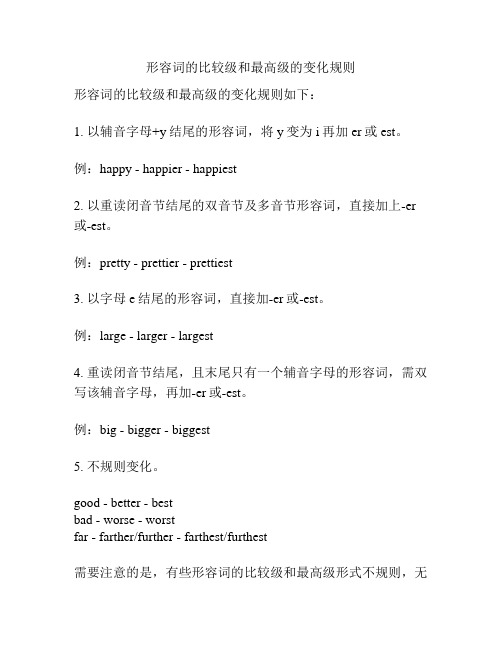
形容词的比较级和最高级的变化规则形容词的比较级和最高级的变化规则如下:1. 以辅音字母+y结尾的形容词,将y变为i再加er或est。
例:happy - happier - happiest2. 以重读闭音节结尾的双音节及多音节形容词,直接加上-er 或-est。
例:pretty - prettier - prettiest3. 以字母e结尾的形容词,直接加-er或-est。
例:large - larger - largest4. 重读闭音节结尾,且末尾只有一个辅音字母的形容词,需双写该辅音字母,再加-er或-est。
例:big - bigger - biggest5. 不规则变化。
good - better - bestbad - worse - worstfar - farther/further - farthest/furthest需要注意的是,有些形容词的比较级和最高级形式不规则,无法按上述规则变化,需记忆。
以下是一些常见的形容词的比较级和最高级的不规则变化:1. 大小、多少类:little - less - leastmuch/many - more - most2. 好坏类:good - better - bestbad/ill - worse - worst3. 不规则变化:far - farther/further - farthest/furthestold - older/elder - oldest/eldestlate - later - latestnarrow - narrower - narrowestshort - shorter - shortesttall - taller - tallestyoung - younger - youngest需要注意的是,有些形容词的比较级和最高级形式既可不规则变化,又可按规则变化。
例如,fast可以变成faster/fastest或more/most fast。
形容词的比较级

形容词的比较级形容词是我们用来描述人、事、物的词语,而比较级则是用来表示两个或多个事物之间的程度、大小、数量等差异的词形变化形式。
形容词的比较级能够帮助我们更加准确地表达事物之间的差异,让我们来详细了解一下形容词的比较级以及它在表达中的应用。
一、形容词的比较级构成方式形容词的比较级通常有以下几种构成方式:1. 在形容词后面加上-er例如:- 大 -- 大的 (big -- bigger)- 快 -- 快的 (fast -- faster)- 高 -- 高的 (tall -- taller)2. 在形容词后面加上辅音字母+y,并将-y变为-i,然后再加上-er例如:- 漂亮 -- 更漂亮的 (pretty -- prettier)- 有趣 -- 更有趣的 (funny -- funnier)- 聪明 -- 更聪明的 (smart -- smarter)3. 在形容词前面加上more例如:- 有名 -- 更有名的 (famous -- more famous)- 幸福 -- 更幸福的 (happy -- more happy)- 美丽 -- 更美丽的 (beautiful -- more beautiful)注意:有些形容词的比较级是不规则的,它们的形式变化与一般规则不同,需要我们单独记忆和掌握,例如:- 好 -- 更好的 (good -- better)- 少 -- 更少的 (little -- less)- 多 -- 更多的 (much -- more)二、形容词的比较级的用法形容词的比较级在英语中有广泛的应用,下面列举一些常见的用法:1. 表示两个事物之间的程度、大小、数量等差异例如:- Tom比Mike更高。
(Tom is taller than Mike.)- 我的狗比你的狗更聪明。
(My dog is smarter than yours.)- 这本书比那本书更有趣。
(This book is funnier than that one.)2. 表示某个事物在同类事物中更具特征或特点例如:- 这家餐厅的服务比其他餐厅更好。
形容词比较级有以下几种变化形式

形容词比较级有以下几种变化形式1.形容词原形加-er,如tall---taller,short---shorter,long---longer,fast---faster,old---older,young---younger,small---smaller等。
2.以辅音字母加-y结尾的形容词,把y改成i,再加-er,如:heavy---heavier,happy---happier,funny---funnier等。
3.重读闭音节结尾的形容词末尾只有一个辅音字母,要双写末尾字母,再加-er,如fat---fatter,thin---thinner,big---bigger,hot---hotter等。
例如:太阳比月亮大。
The sun is bigger than the moon.今天比昨天更热。
Today is hotter than yesterday.4.多音节形容词的比较级要用more加形容词原形,如:beautiful---more beautiful,interesting---more interesting,delicious---more delicious,expensive---more expensive,exciting---more exciting等。
例如:这个钱包比那个更漂亮。
This wallet is more beautiful than that one.他的书比你的书更有意思。
His book is more interesting than yours.5.形容词比较级的不规则变化,如:good/well---better。
你的家人或朋友生病了,你可以说I hope you get better soon.希望您早日康复。
又如:bad---worse,如果你最近很忙,但是又遇到很多麻烦事,你可以说Things can’t be worse.真是糟糕透了!其他常见的不规则变化有:old---older/elder,much/many---more,little---less,far---farther/further。
形容词的比较级和最高级大全
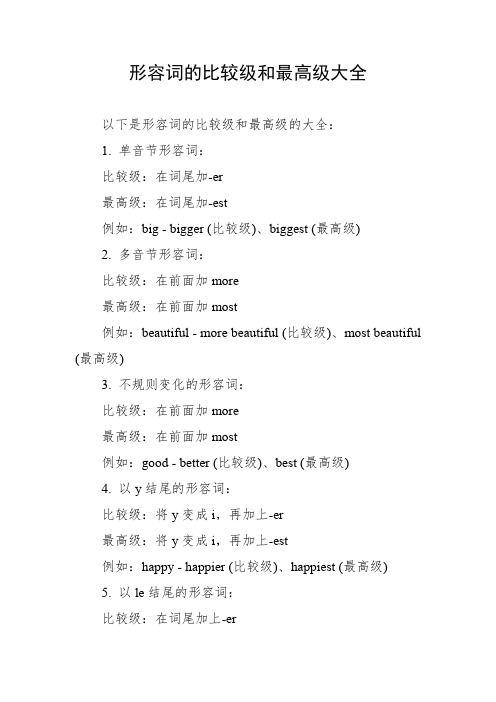
形容词的比较级和最高级大全以下是形容词的比较级和最高级的大全:1. 单音节形容词:比较级:在词尾加-er最高级:在词尾加-est例如:big - bigger (比较级)、biggest (最高级)2. 多音节形容词:比较级:在前面加more最高级:在前面加most例如:beautiful - more beautiful (比较级)、most beautiful (最高级)3. 不规则变化的形容词:比较级:在前面加more最高级:在前面加most例如:good - better (比较级)、best (最高级)4. 以y结尾的形容词:比较级:将y变成i,再加上-er最高级:将y变成i,再加上-est例如:happy - happier (比较级)、happiest (最高级)5. 以le结尾的形容词:比较级:在词尾加上-er最高级:在词尾加上-est例如:possible - more possible (比较级)、most possible (最高级)6. 少数不规则变化的形容词:比较级:在前面加more最高级:在前面加most例如:famous - more famous (比较级)、most famous (最高级)7. 特殊的比较级和最高级:例如:well - better (比较级)、best (最高级)8. 副词的比较级和最高级:比较级:在后面加-er最高级:在后面加-est例如:slowly - more slowly (比较级)、most slowly (最高级)以上是常见的形容词的比较级和最高级,但是也有一些不规则变化的形容词需要记忆。
同时,需要注意的是,有些形容词没有比较级和最高级,如unique。
形容词的比较级大全
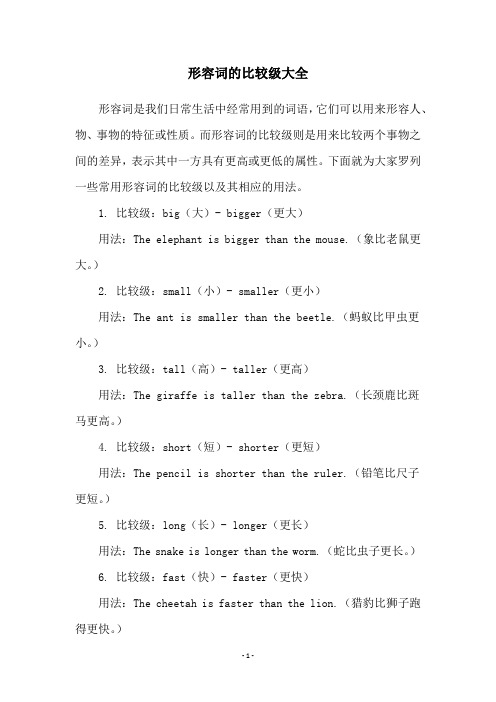
形容词的比较级大全形容词是我们日常生活中经常用到的词语,它们可以用来形容人、物、事物的特征或性质。
而形容词的比较级则是用来比较两个事物之间的差异,表示其中一方具有更高或更低的属性。
下面就为大家罗列一些常用形容词的比较级以及其相应的用法。
1. 比较级:big(大)- bigger(更大)用法:The elephant is bigger than the mouse.(象比老鼠更大。
)2. 比较级:small(小)- smaller(更小)用法:The ant is smaller than the beetle.(蚂蚁比甲虫更小。
)3. 比较级:tall(高)- taller(更高)用法:The giraffe is taller than the zebra.(长颈鹿比斑马更高。
)4. 比较级:short(短)- shorter(更短)用法:The pencil is shorter than the ruler.(铅笔比尺子更短。
)5. 比较级:long(长)- longer(更长)用法:The snake is longer than the worm.(蛇比虫子更长。
) 6. 比较级:fast(快)- faster(更快)用法:The cheetah is faster than the lion.(猎豹比狮子跑得更快。
)7. 比较级:slow(慢)- slower(更慢)用法:The turtle is slower than the rabbit.(乌龟比兔子跑得更慢。
)8. 比较级:easy(容易)- easier(更容易)用法:The multiple-choice test is easier than the essay test.(选择题比论述题更容易。
)9. 比较级:difficult(困难)- more difficult(更困难)用法:Calculus is more difficult than algebra.(微积分比代数更困难。
形容词比较级有以下几种变化形式

形容词比较级有以下几种变化形式1.形容词原形加-er,如tall---taller,short---shorter,long---longer,fast---faster,old---older,young---younger,small---smaller等。
2.以辅音字母加-y结尾的形容词,把y改成i,再加-er,如:heavy---heavier,happy---happier,funny---funnier等。
3.重读闭音节结尾的形容词末尾只有一个辅音字母,要双写末尾字母,再加-er,如fat---fatter,thin---thinner,big---bigger,hot---hotter等。
例如:太阳比月亮大。
The sun is bigger than the moon.今天比昨天更热。
Today is hotter than yesterday.4.多音节形容词的比较级要用more加形容词原形,如:beautiful---more beautiful,interesting---more interesting,delicious---more delicious,expensive---more expensive,exciting---more exciting等。
例如:这个钱包比那个更漂亮。
This wallet is more beautiful than that one.他的书比你的书更有意思。
His book is more interesting than yours.5.形容词比较级的不规则变化,如:good/well---better。
你的家人或朋友生病了,你可以说I hope you get better soon.希望您早日康复。
又如:bad---worse,如果你最近很忙,但是又遇到很多麻烦事,你可以说Things can’t be worse.真是糟糕透了!其他常见的不规则变化有:old---older/elder,much/many---more,little---less,far---farther/further。
形容词比较级和最高级规律和不规则变化

形容词比较级和最高级规律和不规则变化形容词的比较级和最高级有规律性的变化和不规则变化两种形式。
规律比较级的变化:1. 单音节形容词和部分双音节形容词在末尾加上-er来表示比较级。
例如:big(大)- bigger(较大),fast(快)- faster(较快)。
2. 多音节形容词和所有以-y结尾的形容词,在形容词前面加上more来表示比较级。
例如:beautiful(美丽)- more beautiful (更美丽),busy(忙碌)- more busy(更忙碌)。
3. 以字母-e结尾的形容词,在末尾加上-r来表示比较级。
例如:wide(宽)- wider(较宽),nice(好)- nicer(较好)。
4. 以“辅音字母+y”结尾的形容词,将-y改为-i,再加上-er来表示比较级。
例如:happy(快乐)- happier(更快乐),busy(忙碌)- busier(更忙碌)。
规律最高级的变化:1. 形容词末尾加上-est来表示最高级。
例如:big(大)- biggest (最大),fast(快)- fastest(最快)。
2. 形容词前面加上most来表示最高级。
例如:beautiful(美丽)- most beautiful(最美丽),busy(忙碌)- most busy(最忙碌)。
不规则变化:有一些形容词的比较级和最高级是不规则的,需要记住它们的变化形式。
例如:1. good(好)- better(较好)- best(最好)2. bad(坏)- worse(较坏)- worst(最坏)3. many(多)/much(多)- more(更多的)- most(最多的)4. little(小)- less(较小)- least(最小)需要注意,有些形容词的比较级和最高级既可以使用规律变化形式,也可以使用不规则变化形式,根据上下文来决定使用哪种变化形式。
比较级的形容词

在英语中,形容词的比较级用于比较两个事物或人的特征。
通常情况下,比较级的形成有以下规则:1. 对于单音节形容词,通常在词尾加上 "-er" 来形成比较级。
- Fast → Faster- Small → Smaller- High → Higher2. 对于部分双音节形容词,也可以在词尾加上"-er",尤其是那些以"y" 结尾的形容词,变 "y" 为 "i" 再加 "-er"。
- Happy → Happier- Easy → Easier- Pretty → Prettier3. 对于多音节形容词和部分双音节形容词,通常在形容词前面加上 "more" 来形成比较级。
- Beautiful → More beautiful- Expensive → More expensive- Important → More important4. 不规则形容词的比较级需要单独记忆,因为它们不遵循上述规则。
- Good → Better- Bad → Worse- Far → Farther/Further使用比较级时,通常会和 "than" 这个词一起使用来进行比较。
例如:- She is happier than I am.- This book is more interesting than that one.- He runs faster than she does.记住这些规则可以帮助你正确地使用和构造英语形容词的比较级。
常见形容词的比较级和最高级有哪些
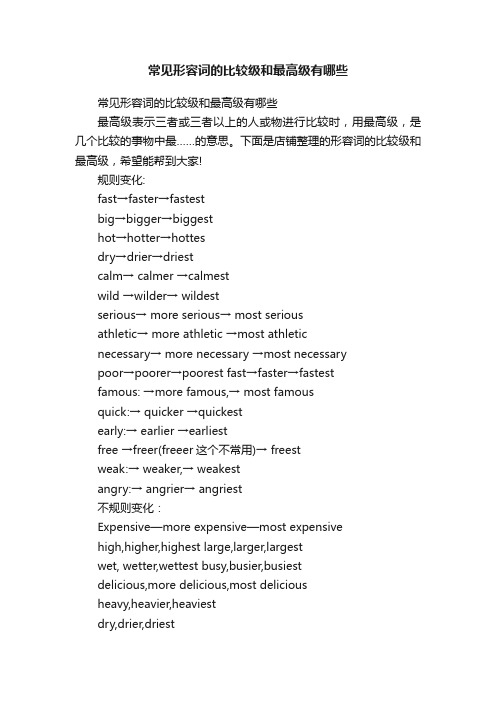
常见形容词的比较级和最高级有哪些常见形容词的比较级和最高级有哪些最高级表示三者或三者以上的人或物进行比较时,用最高级,是几个比较的事物中最……的意思。
下面是店铺整理的形容词的比较级和最高级,希望能帮到大家!规则变化:fast→faster→fastestbig→bigger→biggesthot→hotter→hottesdry→drier→driestcalm→ calmer →calmestwild →wilder→ wildestserious→ more serious→ most seriousathletic→ more athletic →most athleticnecessary→ more necessary →most necessarypoor→poorer→poorest fast→faster→fastestfamous: →more famous,→ most famousquick:→ quicker →qu ickestearly:→ earlier →earliestfree →freer(freeer这个不常用)→ freestweak:→ weaker,→ weakestangry:→ angrier→ angriest不规则变化:Expensive—more expensive—most expensivehigh,higher,highest large,larger,largestwet, wetter,wettest busy,busier,busiestdelicious,more delicious,most deliciousheavy,heavier,heaviestdry,drier,driesteasy easier easiestlazy lazier laziestpretty prettier prettiestnaughty naughtier naughtiestmealy mealier mealiestearly earlier earliestthirsty thirstier thirstiestfar→farther→farthestfar→further→furthestDull—duller--dullestLoud-louder--loudestBoring—more boring—most boringCreative—more creative—most creativeWarm---warmer--warmestgood / well→better→bestbad / ill→worse→worstmany / much→more→mostlittle→less→leastlate→later→ / latestlate→latter→last【拓展】关于形容词和副词的比较级一、含义1. 大多数形容词和副词有三个等级:原级、比较级、最高级: good – better - best2. 比较级:表示两者(人或物)之间的比较。
形容词的比较级与最高级的例词

形容词的比较级与最高级的例词形容词是用来描述人、事物、情感和行为特征的词语,而形容词的比较级和最高级则是用来对不同事物或人的特征进行比较和排序。
在英语中,形容词的比较级和最高级有一定的构造规则和用法。
下面将以几个常见的形容词为例,详细介绍形容词的比较级和最高级。
1. Tall(高):- 比较级:taller(更高的)- 最高级:tallest(最高的)举例:- My brother is taller than me.(我的哥哥比我高)- John is the tallest student in our class.(约翰是我们班最高的学生)2. Bright(明亮的):- 比较级:brighter(更明亮的)- 最高级:brightest(最明亮的)举例:- The sun is brighter than the moon.(太阳比月亮更明亮)- This room has the brightest light.(这个房间有最亮的光线)3. Fast(快的):- 比较级:faster(更快的)- 最高级:fastest(最快的)举例:- The cheetah is faster than any other animal.(猎豹是比其他动物都更快的)- Usain Bolt is the fastest sprinter in the world.(尤塞恩·博尔特是世界上最快的短跑运动员)4. Delicious(美味的):- 比较级:more delicious(更美味的)- 最高级:most delicious(最美味的)举例:- The cake is more delicious than the cookies.(蛋糕比饼干更美味)- This restaurant serves the most delicious food in town.(这家餐厅提供镇上最美味的食物)5. Interesting(有趣的):- 比较级:more interesting(更有趣的)- 最高级:most interesting(最有趣的)举例:- The book is more interesting than the movie.(这本书比电影更有趣)- The history museum was the most interesting place we visited.(历史博物馆是我们参观的最有趣的地方)通过上述例子,我们可以看到形容词的比较级和最高级的构造方式。
形容词的比较级形式
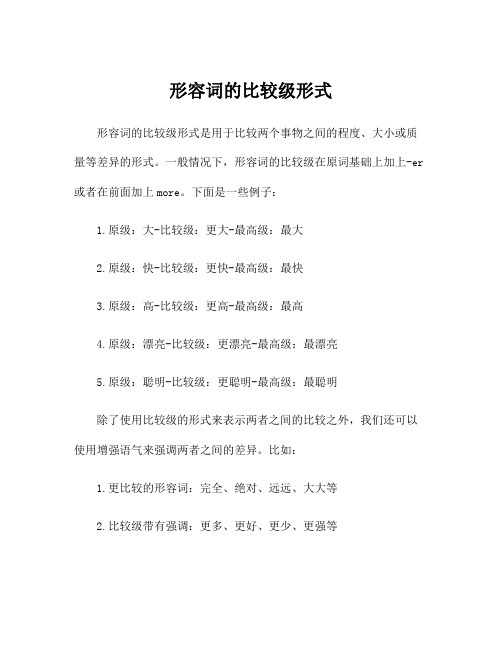
形容词的比较级形式
形容词的比较级形式是用于比较两个事物之间的程度、大小或质量等差异的形式。
一般情况下,形容词的比较级在原词基础上加上-er 或者在前面加上more。
下面是一些例子:
1.原级:大-比较级:更大-最高级:最大
2.原级:快-比较级:更快-最高级:最快
3.原级:高-比较级:更高-最高级:最高
4.原级:漂亮-比较级:更漂亮-最高级:最漂亮
5.原级:聪明-比较级:更聪明-最高级:最聪明
除了使用比较级的形式来表示两者之间的比较之外,我们还可以使用增强语气来强调两者之间的差异。
比如:
1.更比较的形容词:完全、绝对、远远、大大等
2.比较级带有强调:更多、更好、更少、更强等
此外,有一些形容词的比较级形式是不规则的,需要特别记忆,例如:
1.原级:好-比较级:更好-最高级:最好
2.原级:少-比较级:较少或更少-最高级:最少
3.原级:远-比较级:较远或更远-最高级:最远
在实际应用中,可以根据需要使用适当的比较级形式来表达差异和强调。
形容词比较级大全总结
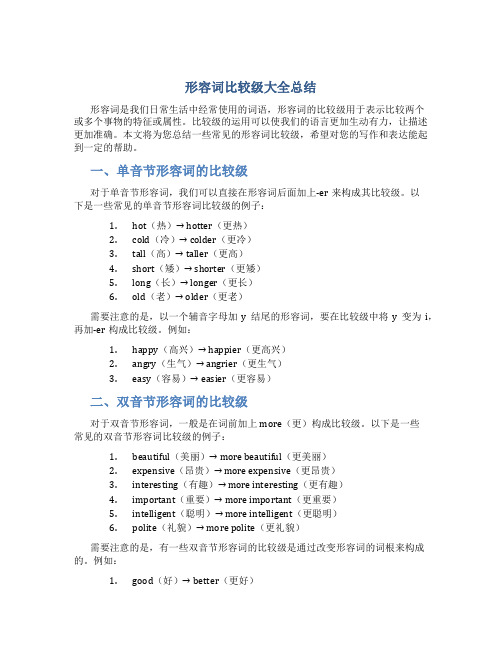
形容词比较级大全总结形容词是我们日常生活中经常使用的词语,形容词的比较级用于表示比较两个或多个事物的特征或属性。
比较级的运用可以使我们的语言更加生动有力,让描述更加准确。
本文将为您总结一些常见的形容词比较级,希望对您的写作和表达能起到一定的帮助。
一、单音节形容词的比较级对于单音节形容词,我们可以直接在形容词后面加上-er来构成其比较级。
以下是一些常见的单音节形容词比较级的例子:1.hot(热)→ hotter(更热)2.cold(冷)→ colder(更冷)3.tall(高)→ taller(更高)4.short(矮)→ shorter(更矮)5.long(长)→ longer(更长)6.old(老)→ older(更老)需要注意的是,以一个辅音字母加y结尾的形容词,要在比较级中将y变为i,再加-er构成比较级。
例如:1.happy(高兴)→ happier(更高兴)2.angry(生气)→ angrier(更生气)3.easy(容易)→ easier(更容易)二、双音节形容词的比较级对于双音节形容词,一般是在词前加上more(更)构成比较级。
以下是一些常见的双音节形容词比较级的例子:1.beautiful(美丽)→ more beautiful(更美丽)2.expensive(昂贵)→ more expensive(更昂贵)3.interesting(有趣)→ more interesting(更有趣)4.important(重要)→ more important(更重要)5.intelligent(聪明)→ more intelligent(更聪明)6.polite(礼貌)→ more polite(更礼貌)需要注意的是,有一些双音节形容词的比较级是通过改变形容词的词根来构成的。
例如:1.good(好)→ better(更好)2.bad(坏)→ worse(更坏)3.little(小)→ less(更小)三、三音节及以上形容词的比较级对于三音节及以上的形容词,一般也是在词前加上more(更)构成比较级,或者通过改变形容词的词根来构成比较级。
形容词的比较级

在形容词比较级后,通常不直接加定冠词“the”。
详细描述
在英语语法中,定冠词“the”用于特指某个或某些特 定的人、事物或概念。而在形容词比较级的用法中, 比较的是两个或更多事物的一般属性或特征,因此不 需要特指某个特定的对象,所以通常不直接在比较级 后加定冠词“the”。例如,“I have a bigger car than the one you have”这句话是错误的,因为 “bigger”后面不应该直接加“the”。
形容词比较级与否定词连用
总结词:表示强调
详细描述:形容词的比较级与否定词连用时,还可以表示强调,突出某个属性或特 征的特殊性或与众不同之处。例如,“He is not the tallest person in the room, he is the shortest.”(他不是房间里最高的人,而是最矮的人。)
总结词
在形容词比较级前,通常不加冠词,如“a”或“the”。
详细描述
形容词比较级用于描述两个或更多事物之间的相对差异,冠 词用于限定名词,因此在比较级中并不需要添加冠词。例如 ,“apples are bigger than oranges”中,形容词比较级 “bigger”前没有加冠词。
比较级后不加定冠词
形容词比较级的构成方法
以“e”结尾的形容词,在后面加 “-r”,例如“nice”的比较级是 “nicer”。
以“辅音字母+y”结尾的形容词, 改“y”为“i”,再加“-er”,例 如“happy”的比较级是 “happier”。
一般在形容词后面直接加“-er”, 例如“tall”的比较级是“taller”。
形容词比较级与副词的搭配使用
总结词
增强表达效果
形容词的比较等级
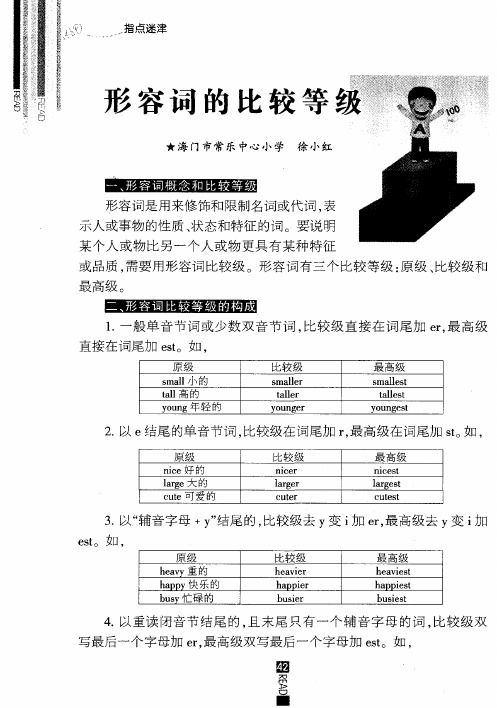
1 形 容 词 的 原 级 用 于 两 个 人 或 事 物 的比 较 , 示 “ 同 ” , 原 级 。 . 表 相 时 用 常 用 结 构 为 “s a +形 容 词 比较 级 +a” s。例 如 ,
( ) h i stla eb y这 个 女 孩 和 这 个 男 孩 一 样 高 。 1T eg l s l st o . r ia a h ( ) c o l a s e v s i 我 的 书 包 和 他 的 书 包 ~ 样 重 。 2 Mysh o b gi a aya s s h h.
2 形容词 的比较级 用于两个 人或 事物 的比较 , 示 “ 比 …更 ” , . 表 … 时
常用结构为“ 形容词比较级 + hn 。例如 , t ” a ( )h rneis a e a e p l 这个橘子比苹果小。 1T eo g l rh n h p . a sm l t t a e
或品质 , 需要用形容词 比较级 。形容词 有三个比较等级 : 原级 、 比较级和
1 一 般 单 音 节 词 或 少 数 双 音 节 词 , 较 级 直 接 在 词 尾 加 e, 高 级 . 比 " l最 直 接在 词 尾 加 et s。如 ,
原级
s l 小 的 ma l t a U高 的 y u g年 轻 的 on
比较 级
s a e m lr l t lr a e l y u gr on e
最 高 级
s a et m ls l t ls a et l yu gs onet
2 以 e结尾 的单 音 节词 , . 比较 级 在 词 尾加 r最 高 级在 词 尾 加 s。 , , t如
原级 nc ie好 的 lre大 的 ag 比较 级 nC r le lre ag r ct ue r 最 高 级 nc s iet lre t ag s
形容词的比较级

形容词的比较级
1. 形容词比较级:taller更高的,shorter更矮的,stronger更强壮的,thinner 更瘦得,older年龄更大的,younger更年轻的,bigger更大的,smaller更小的,longer更长的,heavier更重的。
2. 形容词比较级的构成:
(1). 一般直接加er, 如:tall—taller, short—shorter, small—smaller.
(2). 单音节词如果以e结尾,只加r, 如:strange—stranger.
(3). 闭音节单音节词如末尾只有一个辅音字母,须先双写这个辅音字母,再
加r,如:big—bigger, thin—thinner, hot—hotter
(4). 以辅音字母+y结尾的词,变y为i加er, 如:heavy—heavier, funny-funnier.
(5). 双音节和多音节词在前面加more, 如:more beautiful.
(6). 特殊形式,如:good—better, many—more.
3. A +is(are)+形容词比较级+than +B.
本句是形容词比较级的典型用法,表示A比B更….。
常用在两者在某一方面作比较时,如:You are 10 cm taller than me.你比我高10厘米。
The monkey is thinner that one. 这只猴子比那只瘦。
强化训练
翻译:
1. 你的狗比我的大。
2. 我比你大四岁。
Keys: 1. My dog is bigger than yours. 2. I’m four years older than you.。
- 1、下载文档前请自行甄别文档内容的完整性,平台不提供额外的编辑、内容补充、找答案等附加服务。
- 2、"仅部分预览"的文档,不可在线预览部分如存在完整性等问题,可反馈申请退款(可完整预览的文档不适用该条件!)。
- 3、如文档侵犯您的权益,请联系客服反馈,我们会尽快为您处理(人工客服工作时间:9:00-18:30)。
小学英语语法:形容词和副词的比较级
一.形容词和副词的比较等级
是用来描述和修饰名词或代词的一类词。
用以说明人或事物的性质的特征。
/形容词/副词/或整个句子的一个词。
它可以表达时间,地点,方式,程度,频率,疑问等概念。
二、形容词比较等级:
如:(1)This apple is bigger than that one .
(2):My pen is longer than hers .
(3): He is fatter than me .
(4):You are taller than Linda.
(5):Zhaowei is more beautiful than Zhouhui
比较级前面可以用much, a little 来修饰表示程度。
(6): My watch is much nicer than Ann's
(7):A is a little bigger than B.
than后的人称代词用主格(口语中可用宾格)。
(8):You are more beautiful than I .(me)
+乙。
如:(1)I am as beautiful as you .
(2 ): This book is as interesting as that one .
(3 ): She is as tall as Linda.
(4 ): He is as fat as me .
(5 ): I can run as quickly as he can .
( 6 ): He speaks English as well as Liyang..
2.形容词原形变成比较级加er的规则:(详见附表)
⑴一般在词尾加er ;
⑵以字母e 结尾,加r ;
⑶以一个元音字母和一个辅音字母结尾,应双写末尾的辅音字母,
再加er ;
⑷以“辅音字母+y”结尾,先把y变i,再加er 。
(5)不规则形容词比较级:(详见附表)
一、写出下列形容词或副词的比较级
old__________ young________ tall_______ long___
_____
short________ strong________ big________ small_ ______
fat_________ thin__________ heavy______ light _______
nice_________ good_________ beautiful______________ ____
low__________ high_________ slow_______ fast___ _____
late__________ early_________ far_________ well _____
二、根据句意填入单词的正确形式:
1. My brother is two years __________(old)than me.
2. Tom is as ________(fat) as Jim.
3. Is your sister __________(young) than you? Yes,she is.
4. Who is ___________(thin),you or Helen? Helen is.
5. Whose pencil-box is __________(big),yours or hers? Hers is.
6. Mary’s hair is as __________(long) as Lucy’s.
9.Fangfang is not as _________ (tall) as the other girls.
10.My eyes are __________(big) than ________ (she)..
11.Which is ___________(heavy),the elephant or the pig?
12.The sun is much _________than the earth .(small)
13.Which is____________,a hen or a chick?(big)
三.选择填空。
1.Mary's watch is _______than Ann's .
A.much nice
B. much nicer
C.more nicer
2..We are all very ______,but Jane is ______than us .
A.busy,busier,
B.busier,busy
C.busier,busier
3.The elephant is much _______than the bear
A. heavy
B.heavier
C.heaviest
4.Which is slower,a snail ____a snake?
A.or
B.and
C.with
5.Who has _______books ,Mike or Kate?
A.many
B.much
C.more
6.Tom runs______of all the students.
A.fast
B.the fastest Cfaster。
